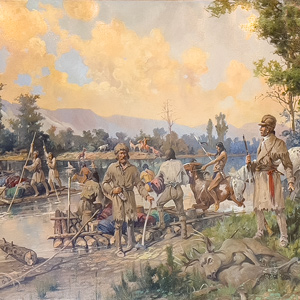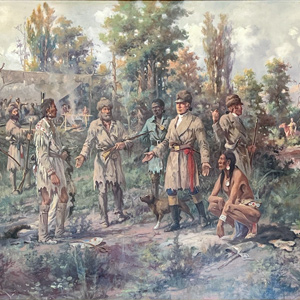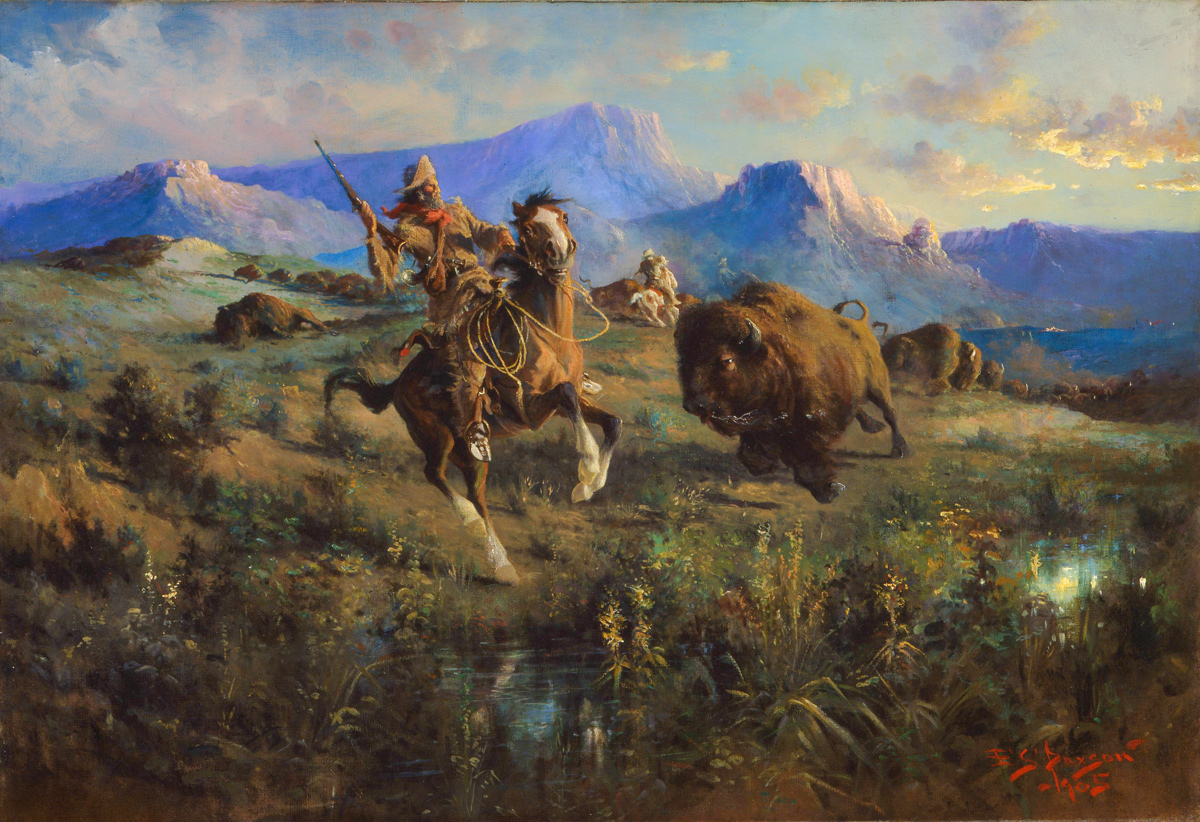In many quarters, Edgar Samuel Paxson (1852-1919), who was entirely self-taught, was one of the most admired, although certainly not the most prominent, of the whole fraternity because his works were the most truthful to the appearance of the land and the people in the northern Rockies where he spent most of his life. Whereas Western artists tended to express nostalgia for a bygone era, Edgar Paxson captured the essence of the fast-disappearing Old West as he personally experienced it. He was not merely an artist-illustrator but a documentary picture maker—an artist-historian.
“Turning the Worm” (Buffalo Hunt)
Edgar S. Paxson, 1905
Oil on canvas, 39 by 26 in. Whitney Gallery of Western Art Collection, gift of Mr. & Mrs. Ernest J. Goppert, Sr., in memory of Mary Jester Allen.
This work has several possible titles: Turning the Worm, Buffalo Hunt, When He is Bad, and When He’s Mad.
—Kristopher K. Townsend, ed.
Edgar Paxson in New York
In 1876, after a few years of painting elaborate scrollwork on carriages in his father’s Buffalo, New York, shop, and already inspired by the novels of James Fenimore Cooper, Edgar set out for the West, empowered by a growing sense of the importance of the events transpiring throughout the American West, and aroused by the injustices suffered by the Sioux in the Black Hills and the ensuing debacle on the Little Bighorn River in southeastern Montana. The Old West was passing away, and he wanted to be in the thick of it. To our everlasting benefit, his driving ambition was to do his part as an artist by documenting those turbulent times for the edification of future generations.
Montana Years
Paxson arrived in Montana less than a year after Custer’s defeat, and his first stop was at the famous battlefield. There he began his many years of research for his masterpiece, “Custer’s Last Stand,” which he finally completed in 1899. His first job in the west was as a hunter for cattle ranchers in the foothills of the Rockies, providing fresh venison for the cowboys. But his preoccupation was minute observation of the land and the lifeways around him, with his pencils, paints and brushes at hand. As a scout and messenger for the ranchers he traveled the Northern Nez Perce Trail—K’useyneisskit—for the first time in 1877, noting in his own journal that the ancient trail was still much as Lewis and Clark might have seen it, deeply gouged in places by the lodgepoles of Indian travois. In 1878 his wife Laura and their three-year-old son rode the Union Pacific Railroad to Ogden, Utah, and then a stage coach to Deer Lodge, where the family settled down together. Two years later they moved to Butte, then one of the fastest-growing cities in the West, situated atop “the richest hill on earth.” For the next ten years Edgar honed his artistic skills by painting curtains and backdrops for John Maguire’s popular theaters in Butte, Anaconda, Bozeman, Deer Lodge, Philipsburg, Livingston and Helena. In 1906 he moved to Missoula, which is situated just a few miles from the site of Travelers’ Rest, and opened a studio.
All the while Edgar industriously cultivated his intimate acquaintance with the raw materials of his art, mountain men and Indians. He wrote, for his own use, “A Dictionary of the Shoshonee Language with a Smattering of other Dialects” consisting of 900 words and phrases, and another lexicon of 450 words and 26 phrases of other dialects. He also developed a working knowledge of Plains Sign Language. Friends and acquaintances of both races often dropped by his studio and wound up posing for his current watercolor, oil, or pencil sketch. He amassed a large collection of “Indian curios,” including several authentic deerskin suits, plus a variety of leggings and moccasins. There were saddles and pouches, and Indian tools and weapons of every description. He was an expert hunter and tracker, and a crack shot; he could jerk meat, dress hides, and make buckskin shirts complete with fringes.
Lewis and Clark Works
Paxson eventually made a comfortable living—for his time, place, and modest lifestyle—from studio work, commissions, and illustrations for books and magazines. All told, he created more than 2,000 drawings, watercolors, and oils, although only about 300 titled works remain, plus several hundred untitled head-and-shoulders watercolors of Indians. Fewer than a dozen of his total output pertained to the Lewis and Clark expedition.[1]Only the last of them, “Sacajawea and Her Dog, Scammon” (1917), may be ignored as forgettable. Paxson owed the name “Scammon” to historian Milo M. Quaife, who addressed the … Continue reading In 1895 he painted “Over the Trail of Lewis and Clark,” his first known scene from that episode in western history. The next title in the catalog of his known works is “Lewis and Clark in Camp on Traveler’s Rest (Lolo) Creek, Montana” (1903), a watercolor commissioned by Olin D. Wheeler as the full-color frontispiece for the first volume of The Trail of Lewis and Clark.[2]Wheeler’s two-volume work, published in 1904, contained some 200 illustrations, comprising the first extensive visual treatment of the Lewis and Clark expedition.
He produced two other black-and-white watercolors expressly for the book, “Lewis and Clark in the Heart of the Bitterroot Mountains,” and “Sacagawea, the Bird Woman,” and provided Wheeler with five images of Indians and frontiersmen from his ever-growing store of documentary works.
His considerable output in 1904 included “Sacagawea at Three Forks, Montana.” Two years later he and his family moved to Missoula, where he opened a studio. Commissions for murals on historical subjects came his way in 1911, when the Montana State Legislature ordered six for the new capitol building. Two of those drew from the Lewis and Clark Story: Lewis and Clark at Three Forks,” and “Lewis at Black Eagle Falls.”
In 1913 he accepted a commission from the Missoula County commissioners to produce eight large murals for the County Courthouse, for the paltry sum of $1,500, roughly half of what they were worth even then. It was another example of his lifelong tendency to undervalue his paintings and drawings. The subjects he agreed to were “Arrival of Father Ravalli at Fort Owen, September 1845”; “Early Transportation”; “The Flatheads in the Buffalo Country”; “The Flatheads Leaving Their Bitterroot Home, October, 1892”[3]In a singular departure from his lifelong commitment to historical truth, Paxson chose to memorialize that enforced exodus of the “Flathead”—properly Salish—tribe in a purely … Continue reading; “Gov. Stevens’ Treaty with the Pend D’Orielles, Flatheads and Kootenais at Council Grove, 9 July 1855”; and “A Montana Roundup.”
Of the greatest interest to us here are the last two of the eight, “Lewis and Clark’s Camp at Travelers’ Rest (Lolo) Creek, 1804”; and “Lewis Party Crossing the Clark’s Fork, 3 July 1806.” See Paxson’s Travelers Rest and Crossing the Clark Fork, respectively.
Principal Source
William Edgar Paxson, Jr., E.S. Paxson: Frontier Artist (Boulder, Colorado: Pruett Publishing Company, 1984).
Pages with Artwork by Paxson


With every crossing they unavoidably drifted farther downstream. Lewis recounted the climactic rafting episode of the day.


At Lewis’s right is Clark’s servant, York, dressed in blue as befitted a personal slave at that time. The Indian squatting at Lewis’s left hand is Toby, the Shoshone guide the captains had hired to lead them across the Bitterroot Mountains toward the Columbia River.
The Cheyennes
by Kristopher K. Townsend

Many, including the expedition members, misheard the people’s name as ‘chien’—French for ‘dog’. Their name actually comes from the Sioux exonym shahíyena, perhaps meaning ‘people of alien speech’. The captains thought that they might make good trading partners.
Notes
| ↑1 | Only the last of them, “Sacajawea and Her Dog, Scammon” (1917), may be ignored as forgettable. Paxson owed the name “Scammon” to historian Milo M. Quaife, who addressed the puzzle of Lewis’s dog’s name, later documents revealing it was actually Seaman, by offering three transcriptions of John Ordway‘s handwritten word, “Scannon,” “Scamon,” and “Semon.” in his edition (1916) of the recently-discovered Journals of . . . John Ordway. Either Paxson bought a copy, or else merely got wind of the options, and made his choice of “Scamon.” Unfortunately, he lost sight of the fact that the dog belonged to Meriwether Lewis, not to Sacagawea. |
|---|---|
| ↑2 | Wheeler’s two-volume work, published in 1904, contained some 200 illustrations, comprising the first extensive visual treatment of the Lewis and Clark expedition. |
| ↑3 | In a singular departure from his lifelong commitment to historical truth, Paxson chose to memorialize that enforced exodus of the “Flathead”—properly Salish—tribe in a purely imaginary mode. He showed the whole tribe mounted on horseback, dressed in their best traditional style, with their belongings on the old-time travois. They march resolutely but proudly, their young warriors cheering them on. The truth was, as contemporary photographs prove, that the utterly impoverished and degraded people, dressed in discarded white men’s clothing and hauling their meager possessions in wagons pulled by the few horses they still owned, and with their few old rifles discreetly hidden, were compelled to walk the sixty-odd miles from their homes in the Bitterroot Valley to their assigned reservation in the Jocko Valley. Paxson’s portrayal was inspired not by nostalgia but by the respect and admiration he had always held toward them. It was the way he wished them to be remembered. It was his eulogy for the late “Old West.” |
Experience the Lewis and Clark Trail
The Lewis and Clark Trail Experience—our sister site at lewisandclark.travel—connects the world to people and places on the Lewis and Clark Trail.
Discover More
- The Lewis and Clark Expedition: Day by Day by Gary E. Moulton (University of Nebraska Press, 2018). The story in prose, 14 May 1804–23 September 1806.
- The Lewis and Clark Journals: An American Epic of Discovery (abridged) by Gary E. Moulton (University of Nebraska Press, 2003). Selected journal excerpts, 14 May 1804–23 September 1806.
- The Lewis and Clark Journals. by Gary E. Moulton (University of Nebraska Press, 1983–2001). The complete story in 13 volumes.


